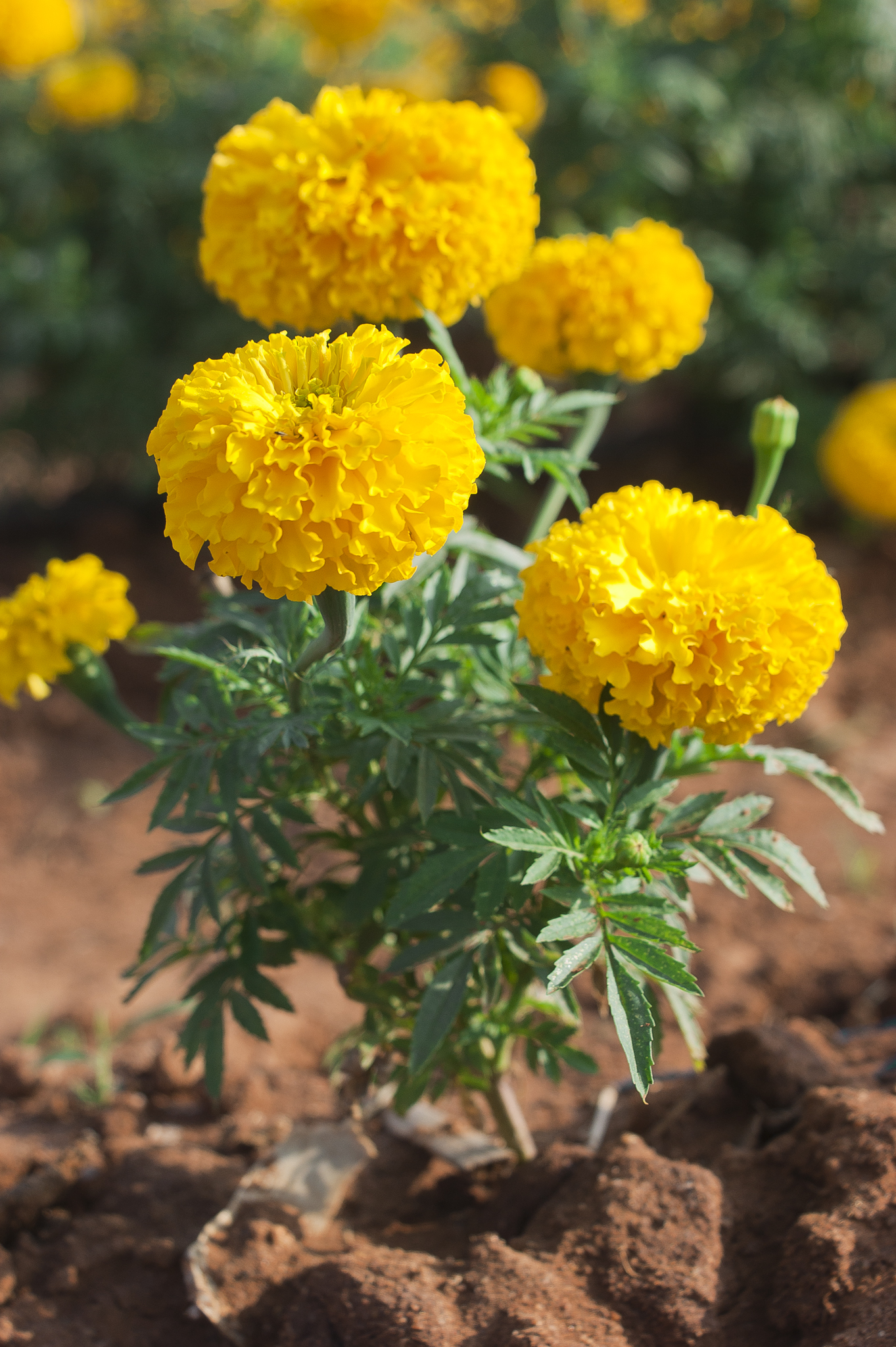Description
Marigolds are cheerful, brilliantly coloured annuals that are long-standing favourite summer flowers for borders and pots. Colours are mainly yellow and orange with some reds and creamy white. All marigolds are excellent for attracting pollinating insects and are enormously useful as companion plants. In Sri Lanka, they are commonly used in religious ceremonies and as natural pest repellents in home gardens. French marigolds (Tagetes patula) and African marigolds (Tagetes erecta) are both well-suited to Sri Lankan conditions. French marigolds are more compact and better suited for small gardens or containers.
Planting requirements
Planting season:
Year-round in most parts of Sri Lanka, with best results during May to September
Planting conditions:
| Propagation | Moisten the soil, then sow seeds 1 inch apart and no more than 1 inch deep |
|---|---|
| Planting method | Requires reasonably fertile well drained soil with a pH between 6.0 to 7.5 |
| Soil | Water well after planting |
| Light | Requires full sunshine |
Growing conditions:
| Temperatures | Prefers daytime temperatures of 21-30°C (70-86°F) and nighttime temperatures around 13°C (55°F). In Sri Lanka, this can be achieved in most regions during the dry season |
|---|---|
| Soil | Better to improve poor soil with well-rotted compost. Add a layer of mulch between plants to suppress weeds and keep soil moist, especially when plants are young |
| Water | Water pot-grown marigolds regularly about 1 inch of water per week |
| Pruning | Not Applicable |
| Weed control | Remove weed |
Harvesting
Marigolds sprout within a week in warm weather and plants typically produce blooms in about 8 weeks. In Sri Lanka's tropical climate, flowering may occur even faster, sometimes within 6-7 weeks.
Curing
Gather the flowers and cut them close to the base. Thread them onto a string, either from bottom to top or side to side. Hang the garland in a cool, dry place away from direct sunlight for 2-3 weeks to help preserve their color.
Storage
Once dried, store marigold flowers in a glass container or airtight bag to keep them free from moisture and pests.
Protecting your plants
Pest control
Pest type:
- Mealybugs
- Aphids
- Spider Mites
- Bud Borers
- Leaf Miners/Thrips
Symptoms:
- Mealybugs: White, cottony masses on young shoots, stems, and leaves; flattened and crinkled leaves turning dark green.
- Aphids: Yellow or brown speckling on leaves; tiny green insects on undersides of leaves and stems.
- Spider Mites: Whitish webs on plants; yellow speckling on leaves.
- Bud Borers: Damage to flower buds, which may appear shriveled or discolored.
- Leaf Miners/Thrips: Leaf distortion and damage due to feeding.
Control method:
- Mealybugs: Spray with Prophenophos at 2 ml/l or fish oil rosin soap at 25 g/l. Use Spinosad at 0.75 ml/l.
- Aphids: Use insecticides containing pyrethrum or spinosad soap.
- Spider Mites: Apply pyrethrum sprays.
- Bud Borers: Spray with Spinosad at 0.75 ml/l.
- Leaf Miners/Thrips: Use Fipronil at 1.5 ml/l.
Disease Control
Disease type:
- Damping Off (Pythium sp.)
- Collar Rot (Phytophthora sp.; Pythium sp.)
- Leaf Spot and Blight (Alternaria, Cercospora, Septoria)
- Powdery Mildew (Oidium sp.; Leveillula taurica)
- Flower Bud Rot (Alternaria dianthi)
Symptoms:
- Damping Off: Seedlings develop necrotic spots and rings, leading to collapse.
- Collar Rot: Black lesions on the main stem, leading to plant death.
- Leaf Spot and Blight: Brown necrotic spots on leaves that enlarge over time, damaging foliage.
- Powdery Mildew: Whitish powdery growth on aerial parts of the plant.
- Flower Bud Rot: Infected buds shrivel and turn dark brown; older leaves show necrotic spots.
Management:
- Damping Off: Soil sterilization with Formalin at 2% before sowing and spraying Dithane Z-78 at 2 g/litre of water.
- Collar Rot: Soil sterilization, controlled watering; use fungicides like Captan and Mancozeb.
- Leaf Spot and Blight: Regular fungicide applications.
- Powdery Mildew: Spray with Sulfex (3 g/litre of water).
- Flower Bud Rot: Use Mancozeb at 2 g/litre of water.
Sources
In addition to our General List of Sources (link), we used these specific references:
- https://www.almanac.com/plant/marigolds
- https://www.thespruce.com/how-to-grow-marigolds-1402909
- https://kisanvedika.bighaat.com/cultivating-marigold-flowers-a-complete-guide-for-a-successful-bloom/
- https://www.epicgardening.com/marigold-companion-plants/
- https://nhb.gov.in/pdf/flowers/marigold/mar002.pdf
- https://agritech.tnau.ac.in/horticulture/horti_flower%20crops_marigold.html
- https://www.epicgardening.com/marigold-problems/
- https://www.gardenary.com/blog/how-to-save-marigold-seeds
